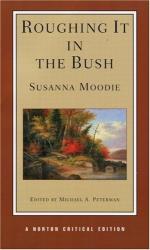The space required for the road is first levelled, ditched, and drained, and then pieces of scantling, five or six inches square, are laid longitudinally on each side, at the proper distance for a road-way twelve feet wide, and with the ends of each piece sawn off diagonally, so as to rest on the end of the next piece, which is similarly prepared, to prevent the road from settling down unequally. The pieces of scantling thus connected are simply bedded firmly in the ground, which is levelled up to their upper edges. Pine planks, three inches thick, are then laid across with their ends resting on the scantling. The planks are closely wedged together like the flooring of a house, and secured here and there by strong wooden pins, driven into auger-holes bored through the planks into the scantling. The common way is to lay the plank-flooring at right angles with the scantling, but a much better way has been adopted in the county of Hastings. The planks are here laid diagonally, which of course requires that they should be cut several feet longer. This ensures greater durability, as the shoes of the horses cut up the planks much more when the grain of the wood corresponds in direction with their sharp edges. When a double track is required, three longitudinal courses of scantling are used, and the ends of the planks meet on the centre one. Very few, if any, iron nails are generally used.
The great advantage of a plank-road is the large load it enables the horses to draw. Whilst on a common road a farmer can only carry twenty-five bushels of wheat in his waggon, a plank-road will enable him to carry forty or fifty bushels of the same grain with a pair of horses. The principal disadvantage of the plank-roads is, that they are found by experience to be injurious to horses, particularly when they are driven quickly on them. They are best adapted for a large load drawn at a slow pace. I shall not attempt to describe the country in the neighbourhood of Belleville, or the more northern parts of the county. It will suffice to observe, that the country is generally much varied in its surface, and beautiful, and the soil is generally excellent. Within the last ten or twelve years the whole country has been studded with good substantial stone or brick houses, or good white painted frame houses, even for thirty miles back, and the farms are well fenced and cultivated, showing undeniable signs of comfort and independence. Streams and water are abundant, and there are several thriving villages and hamlets scattered through the county,—the village of Canniff’s Mills, three miles from Belleville, and soon destined to form a part of it, alone containing a population of about a thousand.
In describing the progress of this county, I may be understood as describing that of most other counties in the Upper Province; the progress of all of them being rapid, though varying according to the advantages of situation or from causes already alluded to.




